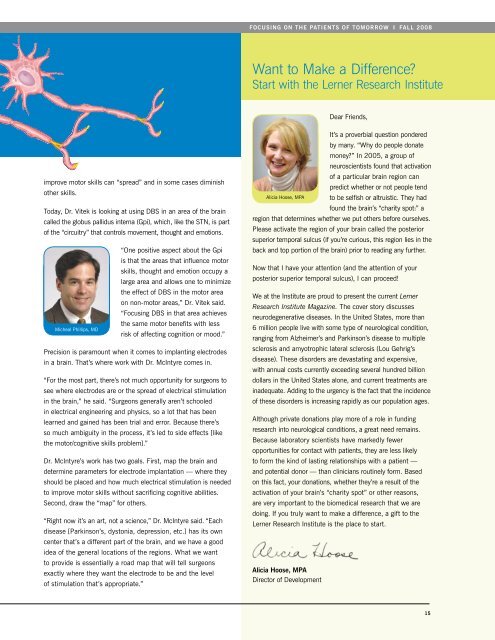Fall 2008 - Cleveland Clinic Lerner Research Institute
Fall 2008 - Cleveland Clinic Lerner Research Institute
Fall 2008 - Cleveland Clinic Lerner Research Institute
Create successful ePaper yourself
Turn your PDF publications into a flip-book with our unique Google optimized e-Paper software.
Focusing on the patients of tomorrow FALL <strong>2008</strong>Want to Make a Difference?Start with the <strong>Lerner</strong> <strong>Research</strong> <strong>Institute</strong>Dear Friends,improve motor skills can “spread” and in some cases diminishother skills.Today, Dr. Vitek is looking at using DBS in an area of the braincalled the globus pallidus interna (Gpi), which, like the STN, is partof the “circuitry” that controls movement, thought and emotions.“One positive aspect about the Gpiis that the areas that influence motorskills, thought and emotion occupy alarge area and allows one to minimizethe effect of DBS in the motor areaon non-motor areas,” Dr. Vitek said.“Focusing DBS in that area achievesMicheal Phillips, MDthe same motor benefits with lessrisk of affecting cognition or mood.”Precision is paramount when it comes to implanting electrodesin a brain. That’s where work with Dr. McIntyre comes in.“For the most part, there’s not much opportunity for surgeons tosee where electrodes are or the spread of electrical stimulationin the brain,” he said. “Surgeons generally aren’t schooledin electrical engineering and physics, so a lot that has beenlearned and gained has been trial and error. Because there’sso much ambiguity in the process, it’s led to side effects [likethe motor/cognitive skills problem].”Dr. McIntyre’s work has two goals. First, map the brain anddetermine parameters for electrode implantation — where theyshould be placed and how much electrical stimulation is neededto improve motor skills without sacrificing cognitive abilities.Second, draw the “map” for others.“Right now it’s an art, not a science,” Dr. McIntyre said. “Eachdisease [Parkinson’s, dystonia, depression, etc.] has its owncenter that’s a different part of the brain, and we have a goodidea of the general locations of the regions. What we wantto provide is essentially a road map that will tell surgeonsexactly where they want the electrode to be and the levelof stimulation that’s appropriate.”It’s a proverbial question ponderedby many. “Why do people donatemoney?” In 2005, a group ofneuroscientists found that activationof a particular brain region canpredict whether or not people tendAlicia Hoose, MPA to be selfish or altruistic. They hadfound the brain’s “charity spot:” aregion that determines whether we put others before ourselves.Please activate the region of your brain called the posteriorsuperior temporal sulcus (if you’re curious, this region lies in theback and top portion of the brain) prior to reading any further.Now that I have your attention (and the attention of yourposterior superior temporal sulcus), I can proceed!We at the <strong>Institute</strong> are proud to present the current <strong>Lerner</strong><strong>Research</strong> <strong>Institute</strong> Magazine. The cover story discussesneurodegenerative diseases. In the United States, more than6 million people live with some type of neurological condition,ranging from Alzheimer’s and Parkinson’s disease to multiplesclerosis and amyotrophic lateral sclerosis (Lou Gehrig’sdisease). These disorders are devastating and expensive,with annual costs currently exceeding several hundred billiondollars in the United States alone, and current treatments areinadequate. Adding to the urgency is the fact that the incidenceof these disorders is increasing rapidly as our population ages.Although private donations play more of a role in fundingresearch into neurological conditions, a great need remains.Because laboratory scientists have markedly feweropportunities for contact with patients, they are less likelyto form the kind of lasting relationships with a patient —and potential donor — than clinicians routinely form. Basedon this fact, your donations, whether they’re a result of theactivation of your brain’s “charity spot” or other reasons,are very important to the biomedical research that we aredoing. If you truly want to make a difference, a gift to the<strong>Lerner</strong> <strong>Research</strong> <strong>Institute</strong> is the place to start.Alicia Hoose, MPADirector of Development15
















